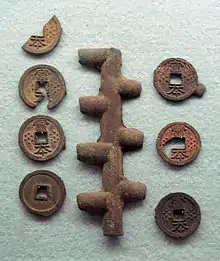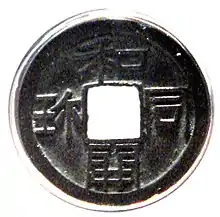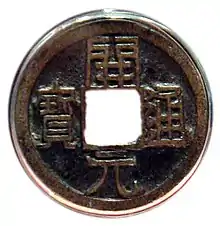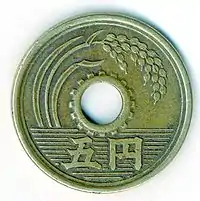Wadōkaichin
Wadōkaichin (和同開珎), also romanized as Wadō-kaichin or called Wadō-kaihō, is the oldest official Japanese coinage, first minted on 29 August 708[1] on order of Empress Genmei.[2][3][4]




Description
The wadōkaichin was first produced following the discovery of large copper deposits in Japan during the early 8th century.[5]
The coins, which were round with a square hole in the center, remained in circulation until 958 CE.[6] These were the first of a series of coins collectively called jūnizeni or kōchō jūnisen (皇朝十二銭).[7]
This coinage was inspired by the Chinese Tang dynasty coinage (唐銭) named Kaigen Tsūhō (Chinese: 開元通宝, Kāiyuán tōngbǎo), first minted in Chang'an in 621 CE. The wadōkaichin had the same specifications as the Chinese coin, with a diameter of 2.4 cm and a weight of 3.75 g.[8]
Etymology
The name wadōkaichin comes from the Japanese pronunciation of the four characters in the coin's inscription: wa (和) dō (同) kai (開) chin (珎).
- The first two characters literally mean "harmony" (和, wa) + "together" (同, dō). This was likely chosen as a fortuitous homophone for the era name Wadō (和銅): the wa (和) is also used to mean "Japan", and dō (同) may also be a ryakuji or abbreviated character for dō (胴) or "copper", in reference to the Japanese copper deposits.[9][10]
- The third character kai (開) literally means "opening; to open", with an additional sense of "start; first".[10][11]
- The fourth character (珎) is unusual. It is considered to be either a variant form of chin (珍) meaning "rare, precious", or a ryakuji or abbreviated character for hō (寳) meaning "treasure, something precious".[9][10][12][11] This difference in interpretation gives rise to the alternative name for the coins, wadōkaihō. Based in part on further research into writing conventions during the Nara period,[9] the broad consensus in modern research appears to be the chin (珍) interpretation.[9][10][12][11]
- → Together, the third and fourth characters likely mean "first currency".
Hoards of Wadōkaichin cash coins
- In February 2015 Japanese archeologists discovered ritual jars filled with wadōkaichin and jingō kaihō (神功開寳) cash coins at the Tehara ruins in Rittō, Shiga Prefecture.[13] The jars were placed there as a part of a Buddhist ritual, which indicates that the site was likely a government office or the resident of an important local.[13]
- On August 17, 2015 four wadōkaichin cache coins were discovered at the East Pagoda of Yakushi-ji, Nara during a restoration.[5] The wadōkaichin were located 1.3 meters east of a foundation rock at the bottom of the 1.7 meter-deep base of the East Pagoda of the temple.[5] Experts from the Nara National Research Institute for Cultural Properties and the Nara Prefectural Archeological Institute of Kashihara believe that the wadōkaichin were buried at the East Pagoda during the groundbreaking ceremony of the Buddhist temple and that these cache coins were used for purification purposes.[5] According to the experts, this discovery at the Yakushi-ji is the oldest known example of the ancient Japanese practice of burying a cache of widely-circulated coins to purify a construction site anywhere in Japan.[5]
Notes
- On the 10th day of the 8th month of the first year of the Wadō era based on the traditional Japanese date, according to Shoku Nihongi
- Titsingh, Isaac (1834), Annales des empereurs du Japon (in French), pp. 63–5.
- Brown, Delmer et al. (1979). Gukanshō, p. 271,
- Varley, H. Paul. (1980). Jinnō Shōtōki. p. 140.
- "Four Wadokaichin Coins Discovered Under East Pagoda of Yakushi-ji Temple". Gary Ashkenazy / גארי אשכנזי (Primaltrek – a journey through Chinese culture). 26 August 2015. Retrieved 6 April 2020.
- Nussbaum, Louis-Frédéric (2005), "Wadō-kaihō", Japan encyclopedia, p. 1024, ISBN 9780674017535; n.b., Authority File, Deutsche Nationalbibliothek.
- Nussbaum, p. 539.
- Japan Currency Museum (日本貨幣博物館) permanent exhibit.
- 2007, Britannica Kokusai Dai-hyakkajiten (ブリタニカ国際大百科事典) (in Japanese), Britannica Japan Co., 和同開珎 (wadōkaichin) entry available online here
- 1988, 国語大辞典(新装版) (Kokugo Dai Jiten, Revised Edition) (in Japanese), Tōkyō: Shogakukan, 和同開珎 (wadōkaichin) entry available online here
- 1995, 大辞泉 (Daijisen) (in Japanese), Tōkyō: Shogakukan, ISBN 4-09-501211-0, 和同開珎 (wadōkaichin) entry available online here
- 2006, 大辞林 (Daijirin), Third Edition (in Japanese), Tōkyō: Sanseidō, ISBN 4-385-13905-9
- Liz Leafloor (3 February 2015). "Rare ritual jars found buried under ancient ruins in Japan intended to purify, bring eternal youth". Ancient-Origins. Retrieved 6 April 2020.
References
- Brown, Delmer M. and Ichirō Ishida, eds. (1979). Gukanshō: The Future and the Past. Berkeley: University of California Press. ISBN 978-0-520-03460-0; OCLC 251325323
- Ponsonby-Fane, Richard. (1959). The Imperial House of Japan. Kyoto: Ponsonby Memorial Society. OCLC 194887
- Nussbaum, Louis-Frédéric and Käthe Roth. (2005). Japan encyclopedia. Cambridge: Harvard University Press. ISBN 978-0-674-01753-5; OCLC 58053128
- Titsingh, Isaac. (1834). Annales des empereurs du Japon (Nihon Odai Ichiran). Paris: Royal Asiatic Society, Oriental Translation Fund of Great Britain and Ireland. OCLC 5850691
- Varley, H. Paul. (1980). A Chronicle of Gods and Sovereigns: Jinnō Shōtōki of Kitabatake Chikafusa. New York: Columbia University Press. ISBN 978-0-231-04940-5; OCLC 6042764

